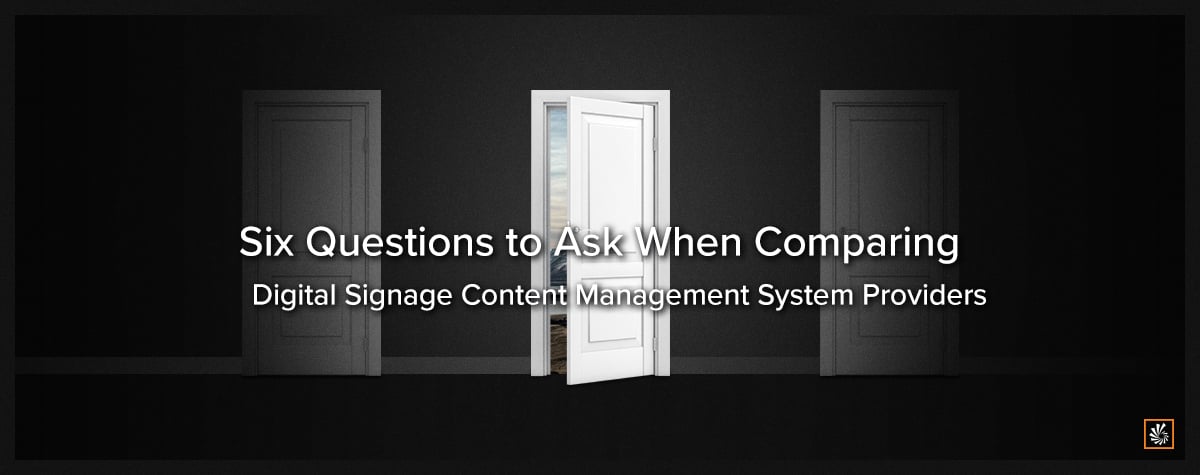What is Your Digital Signage Content Management Plan?
When you’re planning your first digital signage network or upgrading your existing one, you can get excited about all the new devices out there. Given the advances in screen resolutions, connectivity, and interactivity the latest digital screens can offer, who wouldn’t?
It‘s also easy to get excited about the kinds of awesome content your team is going to design and create. We know all about that. At Reflect Systems we’re all about creating engaging experiences for digital signage displays for in-store customers, employees, and audiences in just about any industry.
And you can get excited about the potential for real ROI from your network results, including increased sales, customer loyalty, and customer and employee engagement.
But in all that excitement, don’t forget that you also need a plan for how you'll get that great content out to all those devices. Before you can reap those benefits you are anticipating, you need a digital signage content management plan.
Can a content management plan succeed with the “basics”?
Remember that managing a digital signage network of any size is about more than buying screens and creating great content. The heart and soul of any effective digital signage network is its software—and the software determines a big part of your content management plan.
Of course, if your network has only a few digital screens in a single location with little or no interactivity, a simple plan is adequate—at least to begin with. If your screens are all fairly close to each other, you might even be able to “walk it over” with a jump drive to update your content. (While that’s certainly possible, it doesn’t make for a very dynamic experience for your customers or employees, nor is it convenient or efficient for you.) Instead, you can likely get by with fairly simple content management software which allows you to upload and store your digital content and then transmit it to your devices. However…
More devices, more audiences, more applications—more complexity to manage
If you have dozens or even hundreds of digital signage devices of various types and capabilities, spread over a large area or multiple locations, you need more than “basic” content management functions. You’ll need to organize your content in a library, lay out and arrange the content into coherent playlists, schedule the appropriate files to be sent to your devices automatically, and begin the playback of each at the right time.
Digital signage, of course, isn’t just for playing ad loops to retail customers. It allows you to create engaging, multimedia and even interactive experiences—and not just for retail shoppers. Organizations also use digital signage for corporate communications, employee onboarding and training, and much more. As you begin creating more content for more devices, audiences, and applications, a simpler, less expensive content management software may actually hinder what you can do with your network. It may also limit the results you can expect to see.
As your content management plan becomes more complex, your digital signage content management system (CMS) will likely need to become more sophisticated.
Beyond basic content storage, transmission, and scheduling, an enterprise-level digital signage CMS should allow you to orchestrate complex, engaging experience for multiple audiences in multiple locations. It should provide:
- Templates to allow you to create unique content layouts that combine content formats like video, live streams, text, images, web clippings, and even custom applications
- Granular playback scheduling for each device and each experience, with scheduling capabilities that extend months and even years in the future, if needed
- Optimization of your network so that your content uploads and downloads don’t use critical network bandwidth or impact other critical operational systems (such as your POS)
- Integration with your existing and third-party data sources
- Simplified and centralized device monitoring, management and maintenance
Of course, the number one goal of your digital signage content management plan is to maximize the value of your network while minimizing the cost to support and maintain it. As your operations expand and your digital signage network expands with it, that simply isn’t possible with a basic CMS.
The capabilities mentioned above are a good starting point for ensuring your content management plan is a success, but there are many other details to consider. Next time we’ll do a deeper dive and provide a more comprehensive list of capabilities you should look for in an enterprise-class digital signage CMS. In the meantime, you can visit our ReflectView product page or download our product sheet to see how we can help you manage your content to deliver great experiences as efficiently as possible.
Share this
You May Also Like
These Related Stories

What Is a Digital Signage Content Management System?

Digital Signage Content Management System or Content Creation?


